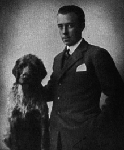Count Folke Bernadotte

(1895-1948)
Folke Bernadotte was born in Stockholm, Sweden, on
January 2, 1895. A descendent of the Napoleonic marshal Jean
Bernadotte, who in 1810 was elected crown prince of Sweden, and in
1818 succeeded to the throne as Charles XIV, Count Bernadotte was
also a grandson of King Oscar II of Sweden and a nephew of King
Gustav V. After graduating from the military school of Karlberg, he
studied horsemanship at the Stromsholm military riding school and
became cavalry office in the Royal Horse Guards. On December 1, 1928,
he married Estelle Romaine Manville, of New York. He represented
Sweden in 1933 at the Chicago Century of Progress Exposition, and in
1939-1940 was Swedish commissioner general at New York World's Fair.
At the beginning of World War
II, as head of the Sveriges Scoutforbund (the Swedish Boy
Scouts), he integrated that organization into Sweden's defense
system, training the scouts in anti-aircraft work and as medical
assistants. His most important war work, however, was as vice
chairman of the Swedish Red Cross, supervising the exchange of
disabled British and German war prisoners. This work necessitated
frequent trips to London and Berlin involving conferences with high
officials of both countries. Just before the end of the war, he led a rescue operation transporting interned Norwegians, Danes and western European inmates from German concentration camps to hospitals in Sweden. Around 15,000 people were taken to safety in the "White Buses of the Bernadotte expedition among them few thousand Jews.
In the spring of 1945, while working in the
Swedish legation's temporary headquarters at Friedrichsruh, Germany,
he was summoned by Heinrich
Himmler, head of the Gestapo and commander-in-chief of the German
home front. They met at Lübeck, Germany, on April 24. Asserting that Hitler was dying and
that he was in authority, Himmler offered the complete surrender of
Germany to Britain and the United States, provided Germany was
allowed to continue resistance against Russia. The Swedish foreign
office transmitted Himmler's offer to Prime Minister Churchill and
President Truman. They in turn notified Premier Stalin, advising him
at the same time of the British-American decision to accept only an
unconditional surrender to the three Allied governments. A
translation of the count's book describing his negotiations was
published in the United States under the title The Curtain Falls (1945).
On May 20, 1948, the five big powers of the United
Nations Security Council agreed in the choice of Count Bernadotte
as mediator to seek peace in the Arab-Jewish
conflict in Palestine. Ten days later he initiated conferences
with Arab and Jewish leaders in Palestine and Arab leaders in Cairo, Egypt, and Amman, Jordan. He succeeded in obtaining agreement to a four-week
truce commencing June 11. On June 28 he submitted to the Arab
League and the Israeli government a peace plan that both sides
rejected in part. On July 12 he made a report to the United Nations
Security Council, in session in New York, and shortly thereafter
returned to Palestine.
On September 17, Count Bernadotte and Colonel
Andre P. Serot of the French air force were assassinated in Jerusalem by members of the Stern
group, an organization of radical Zionists who had committed
numerous attacks over a period of years against the British and
Arabs. Three days after his death, Count Bernadotte's final report on
his peace efforts was published in Paris. It gave the United
Nations General Assembly his suggested terms for a peace that was
to be imposed by the United Nations, and won the immediate support of
the United States and Britain.
Ralph J. Bunche, an American serving as chief
United Nations aide to Bernadotte and as personal representative in
Jerusalem of United Nations Secretary General Trygve Lie, was
appointed Bernadotte's temporary successor.
Bernadotte's book Instead of Arms was
published in Sweden and the United States shortly after his death.
Sources: Folke
Bernadotte Memorial Library, The Encyclopedia Americana, 1988, Hewins, Ralph, Count Folke Bernadotte: His Life and Work, 1950 |